Spring salmon on the River South Esk, Scotland: Scottish Marine and Freshwater Science Vol 7 No 10
Report of a three year project carried out by Marine Scotland to investigate the spring component of the River South Esk salmon stock.
Part 1: Introduction
1.1 The Problem
The abundance of Atlantic salmon at sea has declined across much of its geographical range over the last four decades ( ICES, 2015). In Scotland, a reduction in coastal net fisheries has compensated to a large extent for this decline so that until recent years rod catches have tended to increase and spawning populations have been largely maintained (Gurney et al., 2015). However, rod catches have declined for the component of the salmon stock that returns to rivers early in the year - "spring fish". This decline may reflect a change in strength of the sub-stock and run timing such that salmon may tend to arrive later in the year.
Salmon tend to home to their natal stream and this has resulted in genetic structuring with salmon from specific areas of the catchment leaving and returning at particular times of the year (Laughton & Smith, 1992; Youngson et al., 1994; Stewart et al., 2002; 2006). Direct counts of salmon in two tributaries in the Aberdeenshire River Dee known to be used by spring salmon have identified a trend in numbers of spawning fish that mirrors rod catches more generally. Across most rivers in Scotland, the decline in rod catches of spring salmon has abated over the last decade (Anon., 2015 a). However, this has not been the case in the River South Esk, where catches of spring salmon have continued to decline ( Figure 1.1.1).
Figure 1.1.1
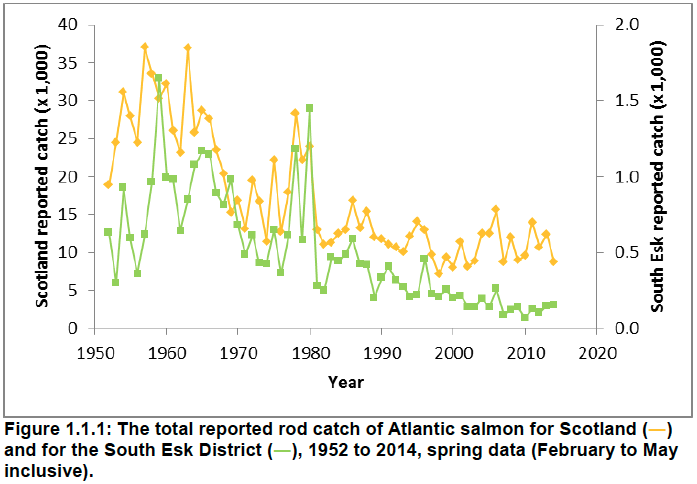
Concern over the decline in spring salmon in the River South Esk has stimulated extensive debate about the potential for management interventions. In 2010, the Esk District Salmon Fishery Board applied to the Scottish Government for measures that were designed to reduce overall exploitation on the early running component of the salmon stock and also sea trout stock in the River South Esk. Scottish Ministers responded by acknowledging that there may be issues with these stocks, noted the shortage of relevant information obtained locally, and instructed Marine Scotland to carry out a three-year demonstration project to investigate the reasons for decline in spring salmon rod catches on the River South Esk. The ensuing investigation addressed the following questions:
- In which geographic region of the River South Esk do spring salmon spawn?
- How does the status of the juvenile salmon stock vary within the River South Esk and how does this relate to spawning regions used by spring fish?
- Is it possible to assess to what extent changes in rod fishing effort have accounted for the declining trend in rod catches of spring salmon?
- What proportion of the catch from the coastal net fishery adjacent to the River South Esk was destined to spawn in the River South Esk?
The outcome of this investigation is summarised in this report.
1.2 The River
The River South Esk catchment is situated in Angus on the east coast of Scotland and drains an area of approximately 564 km 2 ( Figure 1.2.1). The river is approximately 79 km long and rises at an altitude of approximately 975 m on the slopes of Cairn Bannoch (1012 m) in the Eastern Cairngorms (River South Esk Catchment Partnership, 2009; SNIFFER, 2011 a). In its upper reaches, the River South Esk comprises two distinct stems: the main river initially draining Glen Clova; and the Prosen Water ( Figure 1.2.2). These stems join just downstream of Cortachy and the river then flows across fertile agricultural land, passing through the town of Brechin before entering the tidal Montrose Basin and ultimately the North Sea at Montrose ( Figure 1.2.2).
For the purposes of this study, the upper catchment was defined as anywhere upstream of the junction of the Quharity Burn with the main stem of the River South Esk ( Figure 1.2.3). There is a noticeable change in geography here: downstream of this point is characterised by the relatively flat lowlands; upstream of this point, the Prosen Water and the main stem of the River South Esk drain their respective glens in an upland environment.
The river plays a significant role in the local economy, supporting farming, forestry, fisheries, leisure and tourism. The river is ecologically important, providing home to internationally significant populations of Atlantic salmon and freshwater pearl mussels. For these species, the River South Esk is designated a Special Area of Conservation ( SAC) under the European Union ( EU) Council Directive 92/43/ EEC on the Conservation of natural habitats and of wild fauna and flora, commonly known as the Habitats Directive (River South Esk Catchment Partnership, 2009; SNIFFER, 2011 a).
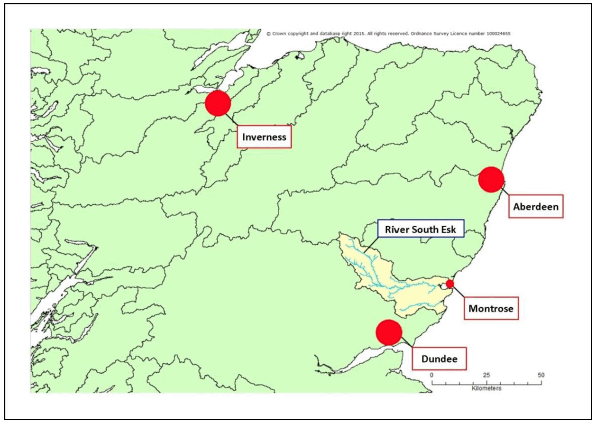
Figure 1.2.1: Location of the South Esk catchment in northeast Scotland. The river enters the sea at Montrose.
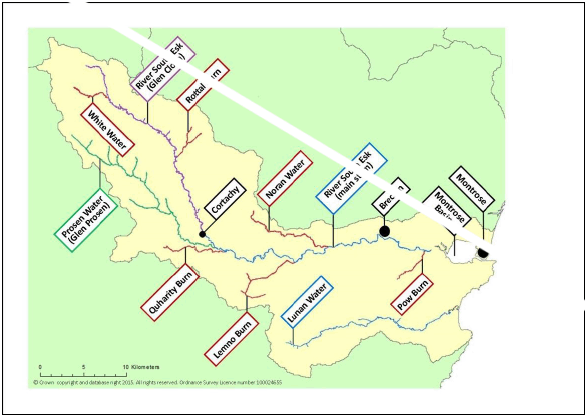
Figure 1.2.2: The South Esk catchment showing the positions of major features including the River South Esk in Glen Clova and the Prosen Water in Glen Prosen, the main stem of the River South Esk, major tributaries, significant settlements and Montrose Basin. Montrose and Brechin, the largest towns in the catchment, are shown by large black dots. Cortachy, a small settlement near the bottom of Glen Clova, is indicated by a small black dot.
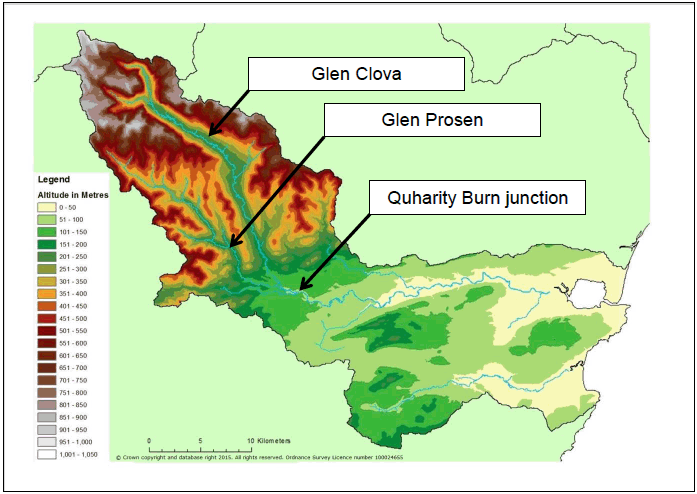
Figure 1.2.3: Relief map of the South Esk catchment showing the obvious change from the upper catchment to the lower catchment at approximately the junction of the Quharity Burn with the main stem of the River South Esk.
1.3 Salmon Fisheries In The South Esk District
There are three main types of gear used to fish for salmon in Scotland - fixed engines, net and coble, and rod and line. All three types of gear have been deployed in the South Esk District for at least part of the period from 1952 (when records began) to 2014.
Effort
Fixed engine fisheries are restricted to the coast and must be set outside estuary limits. Fixed engines have operated in the South Esk District every year from 1952 to 2014. Reported annual netting effort in the fixed engine fishery in the South Esk District peaked in 1972 and has declined over much of the period since ( Figure 1.3.1 a). In 2014, annual netting effort was the ninth lowest since records began in 1952. Reported spring netting effort (for the months of February, March, April and May) in the fixed engine fishery in the South Esk District also peaked in 1972 and has declined over much of the period since ( Figure 1.3.1 b). In 2014, spring netting effort was the second lowest since 1952.
Net and coble fisheries operate in estuaries and the lower reaches of rivers. A net and coble fishery operated in the South Esk District from 1952 until 1998. Reported annual netting effort in the net and coble fishery in the South Esk District peaked in 1972 and declined over much of the period since, until netting operations ceased in 1998 ( Figure 1.3.1 a). Reported spring netting effort in the net and coble fishery in the South Esk District peaked in 1974 and declined over much of the period since, until netting operations stopped in 1998 ( Figure 1.3.1 b). No net and coble fishery has operated in the South Esk District since 1998.
Figure 1.3.1 a
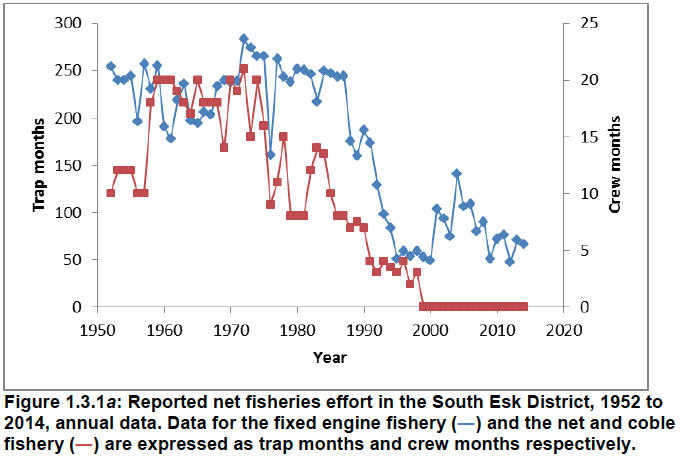
Figure 1.3.1 b
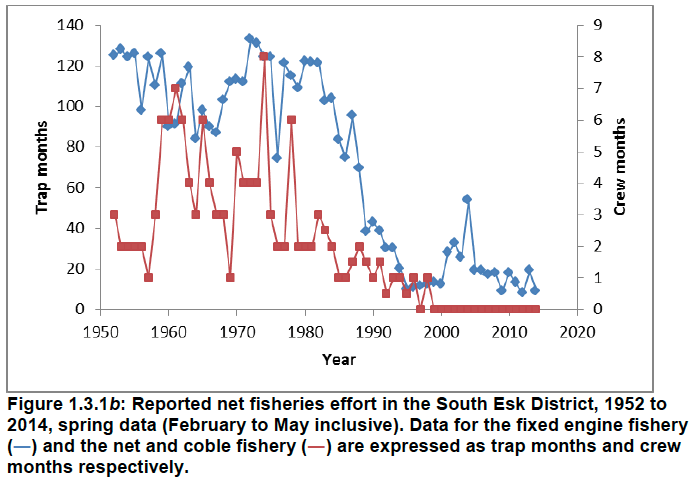
Rod and line is deployed extensively as a method for catching
salmon on the River South Esk. There is no time series of fishing
effort information associated with the rod and line fishery for the
South Esk District.
Catch
The total annual and spring (February to May inclusive) reported nominal catches (i.e. the reported catch of retained salmon) in the South Esk District have declined over the period of recording (1952 to 2014) in all fisheries (Figures 1.3.2 a, 1.3.2 b, 1.3.3 a and 1.3.3 b). This is due to the combination of declining net catches throughout much of the period, the recent drop in reported rod catch and increasing incidence of catch and release in the rod and line fishery. The fixed engine fishery generally dominated both the annual ( 1.3.3 a) and spring ( 1.3.3 b) reported nominal catch over the time series. Nominal catch in the spring is comprised almost exclusively of multi-sea-winter ( MSW) fish in all f`isheries ( 1.3.2 b).
Figure 1.3.2 a
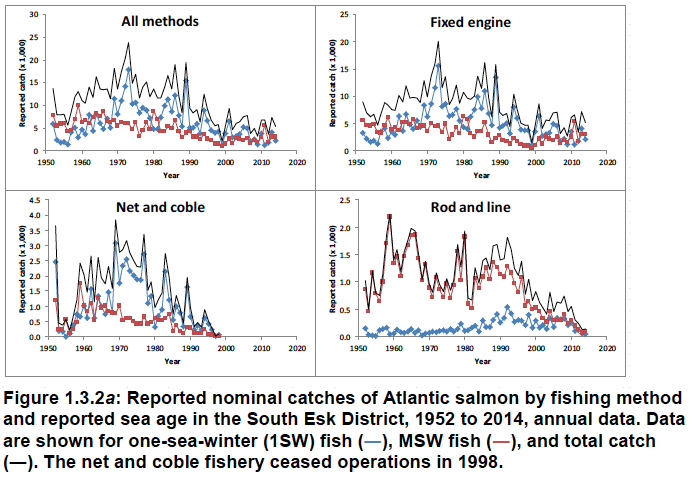
Figure 1.3.2 b
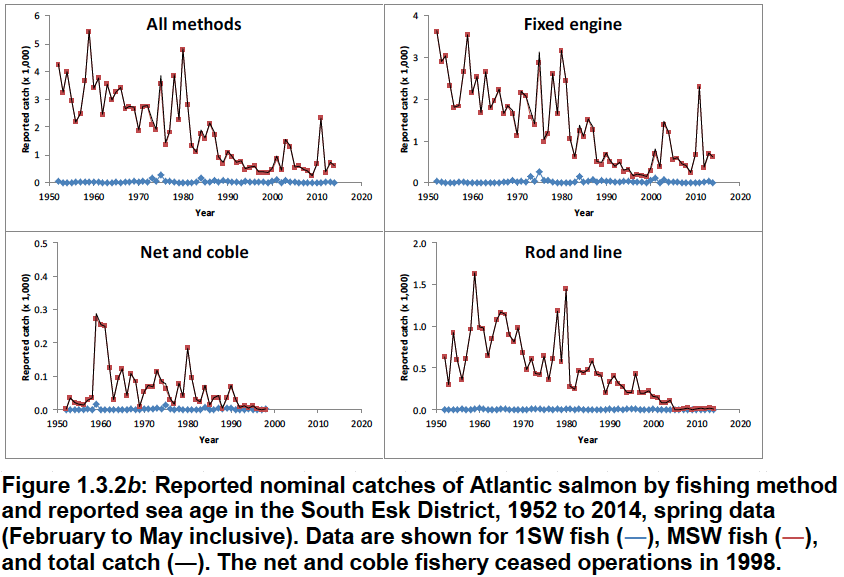
Figure 1.3.3 a
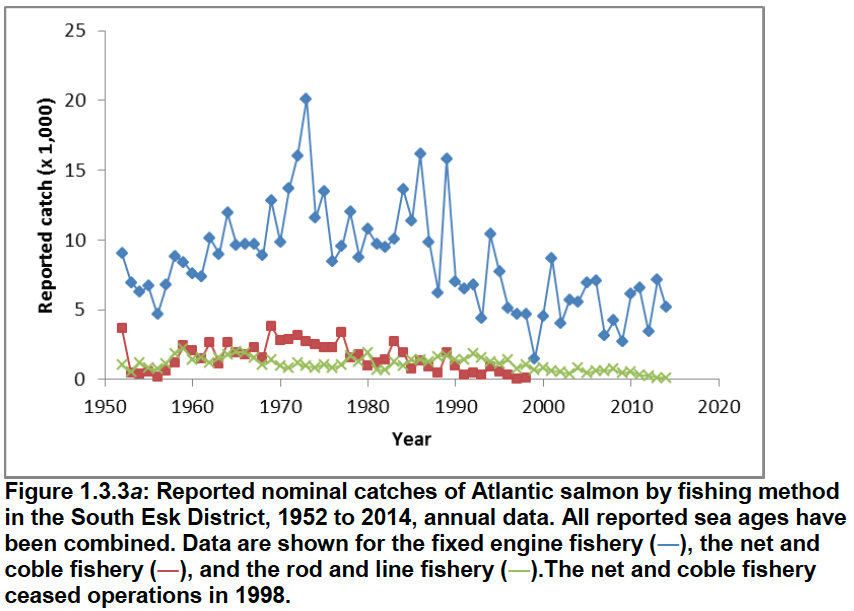
Figure 1.3.3 b
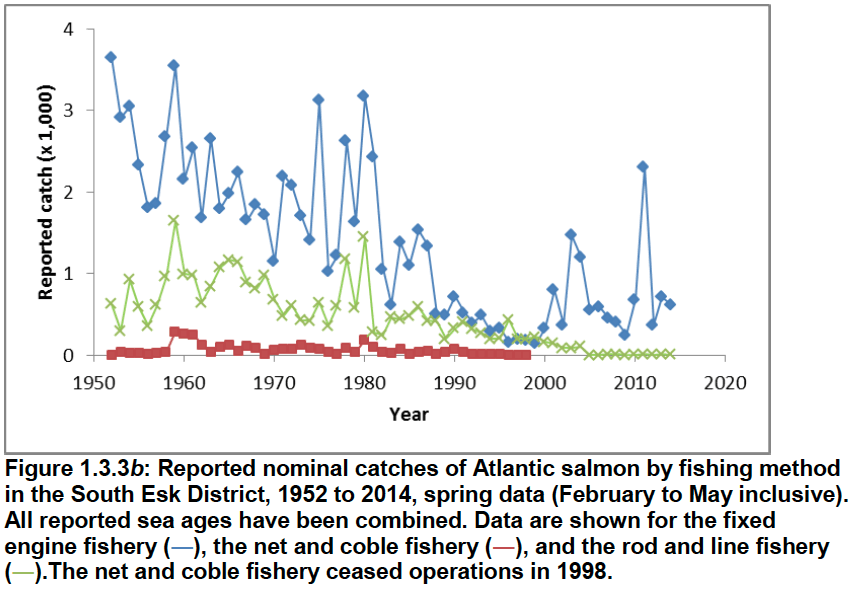
Catch and release in the rod and line fishery
The practice of catch and release in the rod and line fishery has been increasingly common since the early 1990s in Scotland, and reliable statistics have been collected since 1994. In the South Esk District, total annual reported rod catch of salmon and grilse has generally declined over the period 1994 to 2014 ( Figure 1.3.4 a). The proportion of the total annual reported rod catch accounted for by catch and release has generally increased over the same period, from 7.1 % in 1994 to 77.6 % in 2014 ( Figure 1.3.4 a). In the spring (February to May inclusive), total reported rod catch of salmon and grilse has shown a pronounced downward trend over the period 1994 to 2014 ( Figure 1.3.4 b). The proportion of the total spring reported rod catch of salmon and grilse accounted for by catch and release has generally increased over the same period, from 1.5 % in 1994 to 96.8 % in 2014 ( Figure 1.3.4 b). Thus, there has been an increasing tendency to release fish in the rod and line fishery over the period 1994 to 2014 such that in the early part of the time series, retained fish accounted for the majority of the reported rod catch. In recent years, however, released fish account for the majority of the reported rod catch, and this is particularly so in spring.
Figure 1.3.4 a
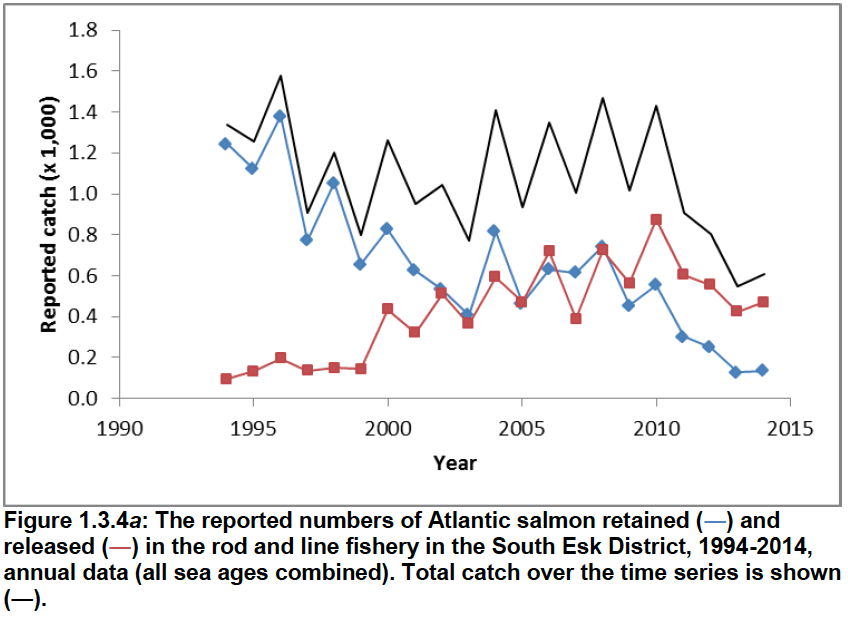
Figure 1.3.4 b
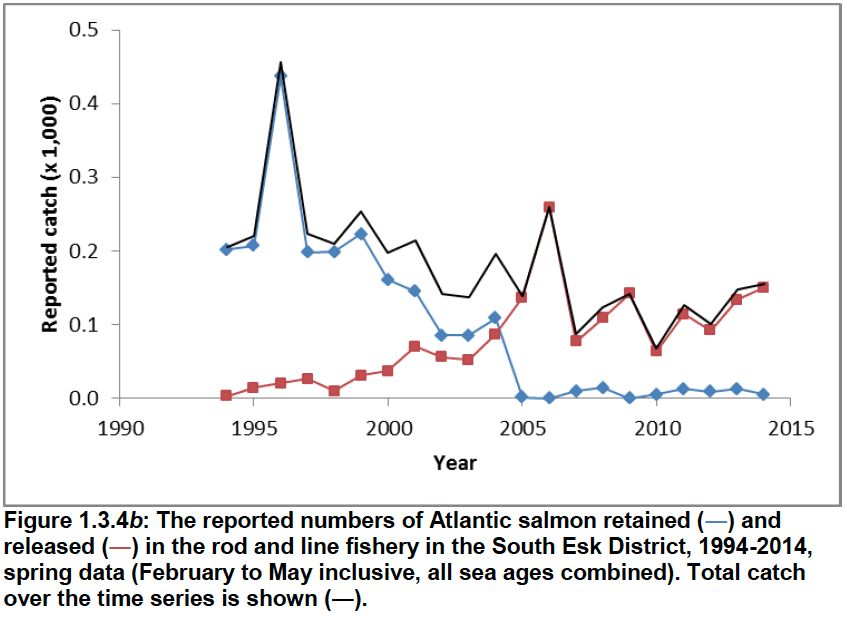
Conservation measures in the spring
In the South Esk District, a compulsory restriction on all net fishing was first introduced in 2005. Under these restrictions, netting was prohibited in the Esk District Salmon Fishery Board area until the 01 May. At the same time, mandatory catch and release for rod fisheries was introduced from the beginning of the season (16 February) until the 31 May. These restrictions covered the 5-year period from 2005 to 2009 after which time a similar voluntary agreement was reached which covered the period 2010 to 2014.
Following consultation in 2014, regulations came into effect in January 2015 which sought to underpin existing voluntary and statutory measures. Under these regulations, the start of the net fishing season is delayed in most areas until 01 April while fishing by rod and line in any given district is restricted to catch and release from the season start date until 31 March. For the Esk District, the previous measures are carried forward - i.e. no net fishing until 01 May. These measures will be reviewed annually.
Contact
There is a problem
Thanks for your feedback